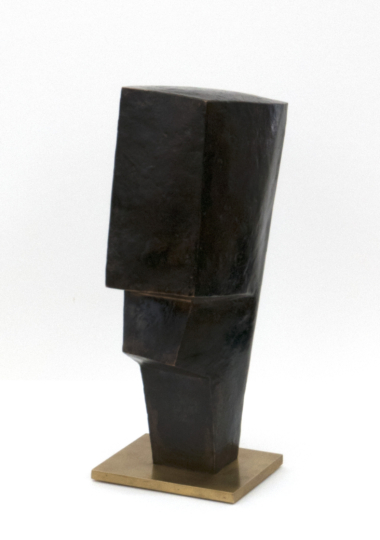Josef PILLHOFER was born in Vienna on 1 June 1921. He grew up in Mürzzuschlag in Styria and attended the School of Arts and Crafts in Graz from 1938 to 1941. From 1946 to 1950 he studied at the Academy of Fine Arts in Vienna under Fritz Wotruba. A state scholarship took the artist to Paris, where he met Ossip Zadkine, Constantin Brancusi and Henri Laurens, among others, whose works significantly influenced his formal language. For Pillhofer, the confrontation with these different artistic languages meant “the basis and starting point for everything else” after his return to Vienna. The artist was represented with his works at the 1954 Venice Biennale, at the “Exposition internationale de sculpture contemporaine” in the Musée Rodin in Paris and at the “9 scultori austriaci” in Florence and in 1956 at the Venice Biennale. From 1954 to 1968 he taught as a lecturer at the Academy of Fine Arts in Vienna. In 1957 a three-month state scholarship took the artist to Rome. In 1964 he participated in the International Exhibition of Contemporary Painting and Sculpture at the Carnegie Institute, Pittsburgh, USA, in the World’s Fair in New York and in the Musée d’Art Moderne de la Ville de Paris, and in 1966 in the Nipputen Exhibition in Tokyo. In 1970 Josef Pillhofer was appointed professor of sculpture at the Kunstgewerbeschule in Graz and led a master class until 1981. In 1972, he was appointed to the post of supplier professor for artistic design at the Technical University of Graz. He held this position until 1974. In 1986 the sculptor lectured at the International Summer Academy in Salzburg. In 2006 Josef Pillhofer bought an old sawmill hall in Neuberg and started to build his own sculpture hall which was opened in 2008. Pillhofer was a member of the Art Club, a member of the Secession and a founding member of the association “Die Gruppe 59”. He received numerous awards and honors, among others. the State Prize of the Academy of Fine Arts in Vienna (1950), the Gifted Prize of the Academy of Fine Arts and the Promotion Prize of the City of Vienna (1952), the Theodor Körner Prize (1956), the Recognition Prize of the Federal Ministry of Education (1958), the Austrian State Prize (1968), the Prize of the City of Vienna (1979), the Appreciation Prize of the Province of Styria (1983), the Great Cross of Merit of the Province of Styria (1996) and the Austrian Cross of Honour for Science and Art (2009). The artist’s works are represented in numerous private and public collections at home and abroad. There is nothing careless, nothing extravagant, nothing superfluous about Pillhofer’s sculptures. Form complexes interpenetrate each other, stagger rhythmically and build steps and overhangs. Josef Pillhofer died on July 30, 2010 in Vienna. 1961 — first exhibition participation, 2001 — first solo exhibition at Galerie Welz.
Josef PILLHOFER was born in Vienna on 1 June 1921. He grew up in Mürzzuschlag in Styria and attended the School of Arts and Crafts in Graz from 1938 to 1941. From 1946 to 1950 he studied at the Academy of Fine Arts in Vienna under Fritz Wotruba. A state scholarship took the artist to Paris, where he met Ossip Zadkine, Constantin Brancusi and Henri Laurens, among others, whose works significantly influenced his formal language. For Pillhofer, the confrontation with these different artistic languages meant “the basis and starting point for everything else” after his return to Vienna. The artist was represented with his works at the 1954 Venice Biennale, at the “Exposition internationale de sculpture contemporaine” in the Musée Rodin in Paris and at the “9 scultori austriaci” in Florence and in 1956 at the Venice Biennale. From 1954 to 1968 he taught as a lecturer at the Academy of Fine Arts in Vienna. In 1957 a three-month state scholarship took the artist to Rome. In 1964 he participated in the International Exhibition of Contemporary Painting and Sculpture at the Carnegie Institute, Pittsburgh, USA, in the World’s Fair in New York and in the Musée d’Art Moderne de la Ville de Paris, and in 1966 in the Nipputen Exhibition in Tokyo. In 1970 Josef Pillhofer was appointed professor of sculpture at the Kunstgewerbeschule in Graz and led a master class until 1981. In 1972, he was appointed to the post of supplier professor for artistic design at the Technical University of Graz. He held this position until 1974. In 1986 the sculptor lectured at the International Summer Academy in Salzburg. In 2006 Josef Pillhofer bought an old sawmill hall in Neuberg and started to build his own sculpture hall which was opened in 2008. Pillhofer was a member of the Art Club, a member of the Secession and a founding member of the association “Die Gruppe 59”. He received numerous awards and honors, among others. the State Prize of the Academy of Fine Arts in Vienna (1950), the Gifted Prize of the Academy of Fine Arts and the Promotion Prize of the City of Vienna (1952), the Theodor Körner Prize (1956), the Recognition Prize of the Federal Ministry of Education (1958), the Austrian State Prize (1968), the Prize of the City of Vienna (1979), the Appreciation Prize of the Province of Styria (1983), the Great Cross of Merit of the Province of Styria (1996) and the Austrian Cross of Honour for Science and Art (2009). The artist’s works are represented in numerous private and public collections at home and abroad. There is nothing careless, nothing extravagant, nothing superfluous about Pillhofer’s sculptures. Form complexes interpenetrate each other, stagger rhythmically and build steps and overhangs. Josef Pillhofer died on July 30, 2010 in Vienna. 1961 — first exhibition participation, 2001 — first solo exhibition at Galerie Welz.








Recent Comments